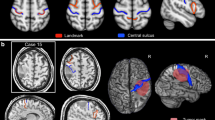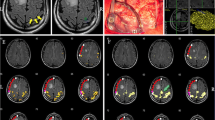Abstract
In patients with brain lesions adjacent to the central area, exact preoperative knowledge of the spatial relation of the tumour to the motor cortex is of major importance. Many studies have shown that functional magnetic resonance imaging (fMRI) is a reliable tool to identify the motor cortex. However, fMRI data acquisition and data processing are time-consuming procedures, and this prevents general routine clinical application. We report a new application of real time fMRI that allows immediate access to fMRI results by automatic on-line data processing. Prior to surgery we examined ten patients with a brain tumour adjacent to the central area. Three measurements were performed at a 1.5-T Magnetom Vision Scanner (Siemens, Forchheim, Germany) on seven patients and at a 1.5-T Intera Scanner (Philips, Best, The Netherlands) on three patients using a sequential finger-tapping paradigm for motor cortex activation versus at rest condition. Blood oxygen level-dependant (BOLD) images were acquired using a multislice EPI sequence (16 slices, TE 60, TR 6000, FOV 210×210, matrix 64×64). The central sulcus of the left hemisphere could be clearly identified by a maximum of cortical activity after finger tapping of the right hand in all investigated patients. In eight of ten patients the right central sulcus was localised by a signal maximum, whereas in two patients the central sulcus could not be identified due to a hemiparesis in one and strong motion artefacts in the second patient. Finger tapping with one side versus rest condition seems to result in more motion artefacts, while finger tapping of the right versus the left hand yielded the strongest signal in the central area. Real time fMRI is a quick and reliable method to identify the central sulcus and has the potential to become a clinical tool to assess patients non-invasively before neurosurgical treatment.

Similar content being viewed by others
References
Ogawa S, Lee TM, Kay AR et al (1990) Brain magnetic resonance imaging with contrast dependent on blood oxygenation. Proc Natl Acad Sci USA 87:9868–9872
Roux FE, Ibarrola D, Lotterie JA et al (2001) Perimetric visual field and functional MRI correlation: implications for image-guided surgery in occipital brain tumours. J Neurol Neurosurg Psychiatry 71:505–514
Stippich C, Freitag P, Kassubek J et al (1998) Motor, somatosensory and auditory cortex localization by fMRI and MEG. Neuroreport 22:1953–1957
Beisteiner R, Windischberger C, Lanzenberger R et al (2001) Finger somatotopy in human motor cortex. Neuroimage 13:1016–1026
Yetkin FZ, Mueller WM, Morris GL et al (1997) Functional MR activation correlated with intraoperative cortical mapping. Am J Neuroradiol 18:1311–1315
Stippich C, Heiland S, Tronnier V et al (2002) Functional magnetic resonance imaging: physiological background, technical aspects and prerequisites for clinical use. Rofo Fortschr Geb Rontgenstr Neuen Bildgeb Verfahr 174(1):43–49
Stippich C, Kress H, Ochmann V et al (2003) Preoperative functional magnetic resonance tomography (FMRI) in patients with rolandic brain tumors: indication, investigation strategy, possibilities and limitations of clinical application. Rofo Fortschr Geb Rontgenstr Neuen Bildgeb Verfahr 175(8):1042–1050
Fernandez G, de Greiff A, von Oertzen J et al (2001) Language mapping in less than 15 minutes: real-time functional MRI during routine clinical investigation. Neuroimage 14:585–594
Kober H, Moeller M, Nimsky C et al (2001) New approach to localize speech relevant brain areas and hemispheric dominance using spatially filtered magnetoencephalography. Hum Brain Mapp 14:236–250
Moeller M, Kober H, Ganslandt O et al (1999) Functional mapping of speech evoked brain activity by magnetoencephalography and its clinical application. Biomed Tech 44:159–161
Hesselmann V, Sorger B, Girnus R et al (2004) Introperative functional MRI as a new approach to monitor deep brain stimulation in Parkinson’s disease. Eur Radiol 14:686–690
Ganslandt O, Fahlbusch R, Nimsky C et al (1999) Functional neuronavigation with magnetoencephalography: outcome in 50 patients with lesions around the motor cortex. J Neurosurg 91:73–79
Beisteiner R, Lanzenberger R, Novak K et al (2000) Improvement of presurgical patient evaluation by generation of functional magnetic resonance risk maps. Neurosci Lett 290:13–16
Dymarkowski S, Sunaert S, Van Oostende S et al (1998) Functional MRI of the brain: localization of eloquent cortex in focal brain lesion therapy. Eur Radiol 8:1573–1580
Nimsky C, Ganslandt O, Kober H et al (1999) Integration of functional magnetic resonance imaging supported by magnetoencephalography in functional neuronavigation. Neurosurgery 44:1249–1255
Braun V, Dempf S, Tomczak R et al (2001) Multimodal cranial neuronavigation: direct integration of functional magnetic resonance imaging and positron emission tomography data: technical note. Neurosurgery 48:1178–1181
Oldfield RC (1971) The assessment and analysis of handedness: the Edinburgh inventory. Neuropsychologia 9:97–113
Author information
Authors and Affiliations
Corresponding author
Rights and permissions
About this article
Cite this article
Möller, M., Freund, M., Greiner, C. et al. Real time fMRI: a tool for the routine presurgical localisation of the motor cortex. Eur Radiol 15, 292–295 (2005). https://doi.org/10.1007/s00330-004-2513-z
Received:
Revised:
Accepted:
Published:
Issue Date:
DOI: https://doi.org/10.1007/s00330-004-2513-z




